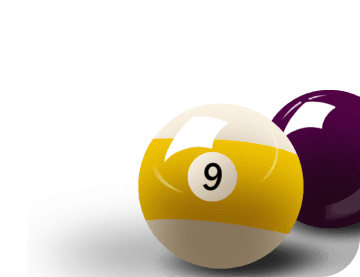What is snooker and how does it differ from pool?

Snooker versus billiards ( pool billiards ) - are they the same? At first glance - yes. Both of these varieties belong to the same group. However, the rules of the game, as well as the histories of the games are quite different. See what the differences are and how easy it is to recognize which variety you are dealing with.
Snooker vs. billiards - are they the same thing? Difference between snooker and pool.
In the following article, when we write billiards - we mean pool billiards (an American variety of billiards).
The answer to the above question is no, although both varieties of billiards do have similar roots, both origins and the detailed rules and even the playing conditions of the game are different.
Billiards vs. snooker: similarities
The similarities between billiards ( pool billiards ) and snooker boil down to the "basics" of the game. More specifically, both games:
- take place on a table equipped with 6 pockets, and the objective is to pocket the balls precisely in these pockets;
- involve hitting a cue ball with a cue
- use billiard cues of similar design (although they are not the same, in snooker, for example, the cap has a smaller diameter ).
See our booking solution for Billiard

Difference between snooker and billiards
So what are the differences between these types of game? There are many more discrepancies in the list of "billiards vs. snooker". Here are the most important ones.
|
|
Snooker - what is it really?
What is snooker? It is an English variety of billiards. While games like 8-ball and others referred to as classic billiards are those that were born in the US.

What is snooker in practice - the rules of the game
How does a game of snooker more or less work? Basically:
- At the beginning of the game, the red balls are set up into a triangle and the 6 colored balls are placed in strictly designated places on the table (3 of them on the edge of the so-called D field, that is, the characteristic semicircle near the bottom band);
- The cue ball is placed by the player "by hand" inside the D field - from there he makes a break with the intention of pocketing at least one red ball;
- When a player sinks a red ball, he gets 1 point, then he can move on to sink any colored ball - depending on the color, it is worth between 2 and 7 points;
- The player must "call" which the colored ball is to be pocketed, that is, say out loud which ball he intends to sink;
- The colored ball, once pocketed, returns to the table at its original position;
- The red balls do not return to the table after falling into a pocket, The player has to alternately aim at a red one and then a colored one;
- When a player fails to pocket a ball after making a strike, the turn passes to the other player;
- When all the red balls are gone, the player then has to pocket the colored balls (they will no longer return to the playing area) - this must be accomplished in the order of their point value, from the smallest to the largest. This means in the order: yellow, green, brown, blue, pink, black;
- The game (frame) ends when all the balls have been pocketed (or if the difference in points between the players is too large) - then a new frame can begin.
An entire match consists most often of several games (called frames), and the final victory is achieved by the player who wins the most frames.
Now that you know what snooker is, you can proceed with the game. Good luck!
Start using our system
FOR FREE





